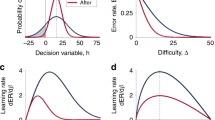Abstract
From Thurstone's theoretical learning curve, a solution for the difficulty of the problem and the learning constant of the subject has been developed. The curve is an equilateral hyperbola. Therefore the semi-major axis represents the learning situation in one constant. The vertex of the curve is a point where all of the animals are equated, since they are all making errors at the rate of one error per trial.
Similar content being viewed by others
References
Lashley, K. S. andL. E. Wiley, “Studies of cerebral function in learning. IX. Mass action in relation to the number of elements in the problem to be learned;”J. Comp. Neur., V. 57, 1933,1, Feb. 15.
Thurstone, L. L., “The learning function.”Journal of General Psychology, 1930,3, 469–493.
Thurstone, L. L., “The error function in maze learning.”Journal of General Psychology, 1933,9, 288–301.
Wiley, L. E. andA. M. Wiley, “Studies in the learning function. I. An empirical test of Thurstone's theoretical learning curve.”Psychometrika, 1937,2, no. 1, 1–20.
Author information
Authors and Affiliations
Additional information
A grant-in-aid from the National Research Council has made the present analysis possible. We wish to express our appreciation, for the aid and encouragement, of Professor Rufus Crane of the mathematics department, Ohio Wesleyan University and of Professor L. L. Thurstone, University of Chicago.
Rights and permissions
About this article
Cite this article
Wiley, L.E., Wiley, A.M. Studies in the learning function. Psychometrika 2, 107–120 (1937). https://doi.org/10.1007/BF02288065
Issue Date:
DOI: https://doi.org/10.1007/BF02288065




